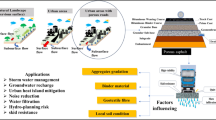Abstract
The stress-strain response of the bituminous pavements is highly sensitive to temperature. To systematically analyze the pavement performance, it is necessary that one understands the variation of pavement temperature spatially and temporally during the life time of a pavement. In this investigation, historic air temperature data for 37 locations across India was collected. Using this database, pavement temperature data was predicted by an appropriate air temperature-pavement temperature model. High and low temperature pavement temperature contours were generated for the first time for India. It was seen that the locations spanning from Srinagar to Madhya Pradesh and Rajasthan to Orissa were extremely critical. The minimum temperature in these locations was \(-\)10 \(^{\mathrm {\circ }}\)C and the maximum temperature was around 68 \(^{\mathrm {\circ }}\)C. Clearly such information is necessary when making choice of binder grade and bituminous layer thickness.





Similar content being viewed by others
References
A.F. Braham, W.G. Buttlar, M.O. Marasteanu, Effect of binder type, aggregate, and mixture composition on fracture energy of hot-mix asphalt in cold climates. Transp. Res. Rec. 2001, 102–109 (2007)
T. Kennedy, G.A. Huber, E.T. Harrigan, R.J. Cominsky, C.S. Hughes, H.L. Von Quintus, J.S. Moulthrop, SHRP-A-410: Superior Performing Asphalt Pavements (Superpave): The Product of the SHRP Asphalt Research Program (Strategic Highway Research Program, National Research Council, Washington DC , 1994)
IRC-37, Guidelines for the design of flexible pavements. Indian Roads Congress, 2001.
AUSTROADS 2008b–4F, Guide to Pavement Technology: Bituminous binders. Association of Australian and New Zealand Road Transport and Traffic Authorities, 2008.
HRS, Temperature and deflection studies on pavements, tech. rep., (Highway Research Station, Chennai, 1971).
A.J. Henry, The Bruckner cycle of climatic oscillations in the United States. Ann. Assoc. Am. Geogr. 17(2), 60–71 (1927)
R.G. Vines, Rainfall patterns in India. Int. J. Climatol. 6(2), 135–148 (1986)
W.P. Kemp, D.G. Burnell, D.O. Everson, A.J. Thomson, Estimating missing daily maximum and minimum temperatures. J. Clim. Appl. Meteorol. 22, 1587–1593 (1983)
P. Coulibaly, N. Evora, Comparison of neural network methods for infilling missing daily weather records. J. Hydrol. 341, 27–41 (2007)
I. Bertini, F. Ceravolo, M. Citterio, M.D. Felice, B.D. Pietra, F. Margiotta, S. Pizzuti, G. Puglisi, Ambient temperature modelling with soft computing techniques. Sol. Energy 84(7), 1264–1272 (2010)
H. Demuth and M. Beale, “Neural network toolbox for use with Matlab”, MATLAB 2007a, (The MathWorks, Natick, 1993).
W. Underground, “http://www.wunderground.com/”, Accessed 30 Nov (2010).
B. A. Smith, R. W. Mcclendon, and G. Hoogenboom, Improving air temperature prediction with artificial neural networks. Int. J. Comput. Intell. 3(3), 179–186 (2007)
M. Hayati, Z. Mohebi, Application of artificial neural networks for temperature forecasting. World. Acad. Sci. Eng. Technol. 28, 159–167 (2007)
J.S. Kern, S.H. Carpenter, Performance graded high temperature selection criterion—can we do it better. Transp. Res. Rec. 1661, 122–131 (1999)
E.S. Barber, Calculation of maximum pavement temperatures from weather reports. Highw. Res. Board 168, 1–8 (1957)
H.A.-A. Wahhab, I. Al-Dubabe, I.M. Asi, M.F. Ali, Performance-based characterization of Arab asphalt. Constr. Build. Mater. 11, 15–22 (1998)
Datapave online, “http://www.ltppproducts.com/datapave/visualization/map.aspx”, Oct 2010
Acknowledgments
The authors are thankful to Department of Science and Technology, Govt. of India for research grant DST/TSG/STS/2011/46 and Indian Meteorological Department, Pune for providing weather data.
Author information
Authors and Affiliations
Corresponding author
Rights and permissions
About this article
Cite this article
Nivitha, M.R., Krishnan, J.M. Development of Pavement Temperature Contours for India. J. Inst. Eng. India Ser. A 95, 83–90 (2014). https://doi.org/10.1007/s40030-014-0074-y
Received:
Accepted:
Published:
Issue Date:
DOI: https://doi.org/10.1007/s40030-014-0074-y




